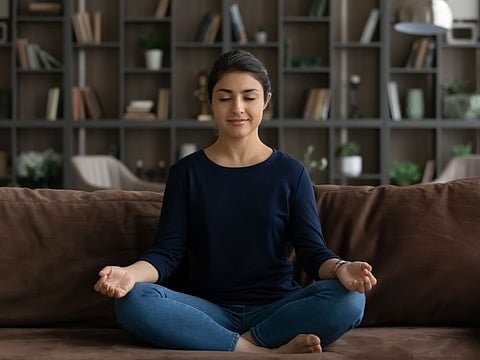Meditate with Urmila: Can’t concentrate during meditation?
If the goal is to experience peace, then removing distractions is the real work

Not being able to concentrate during meditation is one of the peeves of the practitioners.
There are few techniques that will help.
1. Breath awareness: As you inhale and exhale, be aware of the movement of the abdomen. Notice is the abdomen going in or out as you as you inhale and exhale? Another method: As you breathe, notice the pause between your breaths.
2. Body awareness: Mentally scan the body from top of your head to the tip of the toes. Rotate your awareness from top of the head, face, neck to the right side of the body and then to the left side and finally the whole body.
3. Sound awareness: Pick up one external sound from several that you hear and focus on it. Or, engage in chanting.
4. Visualisation: Visualise a soft flame at the heart centre. Or a ray of light coming from top of your head filling your whole body till your pelvic floor.
If attention moves elsewhere from the object of meditation, that is, breath or body, sound/ or visual- bring the attention back to the object. Regularity in practice will help develop the concentration, the one-pointed focus.
Distraction in meditation
Concentration is a skill; it can be learnt. Peace is a subject of experience and can’t be learnt, only experienced. If the goal of meditation is to experience peace in life, then removing distractions is the real work; the inner and the outer distractions. When the distractions are cut down, concentration automatically increases.
The sources of distractions lie at varied levels of one’s consciousness. Where do they lie? These are held in mind and body.
- At the body level, it is catering to the sensory pleasures indiscriminately. Senses seek pleasure, and hence like to be projected outward, engaged in the external world. Not being able to discipline the senses is cause of distraction.
- Hence, high level of engagement with the worldly activities, lending eyes, ears and attention to them (news, social media, social circle, gossip, etc), fragments the attentive capacity of the mind= distraction. In such a scenario, objects compete to occupy the mind space, leaving one’s energies scattered and hooked at several places outside self. Remedy? Reducing external engagements.
- Excessive talking, excessive food consumption without discipline on the quality or quantity, excessive work and workouts, physical and mental exertion fatigues the mind, body. Way out? Balance in all activities.
- Trace back the above points and know that causes of these external distractions go even deeper, at the inner level. The roots of battle lie inside, engaged at the emotional and mental/ thought level. Emotional attachment to feelings such as of greed, lust, lethargy, fantasy, comfort, hoarding of material possessions, coveting and such low state of vibratory influences disrupt concentration. So does hoarding negative feelings of resentment, anger, hate, jealousy. Or regret, guilt, depression, shame, mental violence, fear, anxiety etc.
Emotional and mental disturbances disrupt meditation, waves of thoughts don’t allow concentration at deep level, images and emotions surge up. When mind is at peace, meditation is easy. When is mind at peace? When it is not unnecessarily hooked up at places where it doesn’t need to be.
The Yoga sutras of Maharishi Patanjali proposes mental and emotional purification first, through the practice of ‘yam’ and ‘niyam’ before moving to meditative process. The stages of ‘dharna’, ‘dhyan’ and ‘samadhi’ (concentration, meditation and absorption) finds space in the last three stages of his proposed eight steps of yoga, after the first two, ‘yam’ and ‘niyam’ Yoga sutras prescribe a balanced way of living, to be able to concentrate and be free from emotional bondage and suffering.
How can mind be at peace? By disciplining the senses using the tools of: restraint, renunciation, release of attachment to negative emotions, forgiveness, developing compassion. By tools of self-reflection, higher understanding, spiritual knowledge, doing all things as a spiritual practice.
(To be continued...)
Disclaimer: Urmila Rao is an emotional healer and a forgiveness teacher. All the ideas expressed herein are her own, and not professional advice or medical prescription. Her website is: www.karmicwellness.in Email: hellokarmicwellness@gmail.com
Sign up for the Daily Briefing
Get the latest news and updates straight to your inbox



